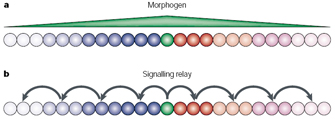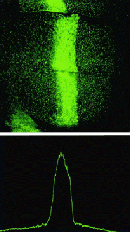« Prev Next »
Relatively speaking, only a small number of genes are involved in determining body patterns during development (Tabata, 2001). The specific signaling molecules that are involved in this process are called morphogens. These molecules are extracellular and are believed to influence tissue morphogenesis by diffusing along the surfaces of cells from a concentrated source. Different concentrations of the morphogen result in the induction or inhibition of gene expression of other genes (Figure 1). As a result, concentration gradients of important regulatory proteins form across the developmental field of an embryo, which defines a positioning value for each cell. Based on the concentration of the regulatory protein in each particular cell, a series of subsequent signals (cascades) and responses to them dictate the direction and extent of cell growth and development (Figure 2). For example, the expression of such gradients controls how long your fingers should be, where your nose is on your face, and other specifics about body structure. Gradient systems are believed to be an economical way for cells to define body patterning, as they make use of a small number of signal molecules to make various cell types, without requiring novel signaling systems for each type.
Morphogen Regulation of Transcription Factor Activity in the Fruit Fly

To learn more about the role of morphogens in bilaterian development, scientists have collected data on the genetics of these proteins in insects, particularly the fruit fly Drosophila melanogaster. This information has yielded several powerful insights. For instance, one good example of a transcription factor regulated by morphogen gradients is decapentaplegic (Dpp), which is expressed in developing wings of fruit flies (Tabata, 2001). In fact, this substance is essential for the growth of wing cells.
In fruit flies, the wing forms from a structure called the larval imaginal disc, which is a sac of epithelial cells that are reserved for future wing development. This disc is subdivided into compartments, with an anterior/posterior (A/P) axis and dorsal/ventral (D/V) axis. P compartment cells are identified by the expression of the selector gene called engrailed (en). The product of engrailed, along with a partner substance, forms a transcription factor that induces a regulatory protein known as hedgehog (Hh), which, in turn, induces expression of Dpp in the P compartment along the D/V axis and diffuses a short distance into the A compartment, where it controls the pattern of the central domain of the wing. The Dpp transcription factor induces the production of a host of target genes, including genes that code for other transcription factors, and it also activates pathways that result in expansion of the wing pattern. Dpp is thus essential for growth of the wing cells and patterning beyond the central domain.
Interestingly, Wg (wingless) protein acts in the anterior wing cells just as Dpp acts in the posterior ones. In addition, each of these proteins acts to block the other; specifically, Dpp is a negative transcription factor for Wg, while Wg interferes with the translation of Dpp. Thus, gene expression is vital to the effectiveness of the gradient in specifying different cell fates.
The presence of a Dpp gradient in fruit fly wings has been demonstrated in living flies using protein fusion. In particular, a green-fluorescent protein (GFP) gene was fused with Dpp to produce a single protein product containing both Dpp and GFP domains. This fusion gene was expressed in Dpp mutant flies (Figure 3; Teleman & Cohen, 2000) and shown to function normally. Using this GFP-tagged version of Dpp allowed investigators to visualize Dpp behavior in living cells. As you can see, Dpp was found in its strongest concentration (visualized as the brightest green fluorescence) down the center of the imaginal disc. The posterior and anterior diffusion of the signal can be seen as the strength of the GFP dims as one moves away from the bright central stripe (Figure 3, top). This diffusion was also quantified by measuring the strength of the GFP signal across the entire imaginal disc (Figure 3, bottom).
Regulating Target Gene Expression
There is thus ample evidence that regulatory gene expression gradients are present in certain regions, and that these gradients play a role in the differentiation of cell types, but exactly how do they do this? It seems that concentration gradients of morphogens outside a cell ultimately impact the activity of transcription factors (activators and repressors) to regulate transcription within the cell's nucleus. The transcription factors transduce the signals of the regulatory protein gradients from the cell surface throughout the cell to the nucleus by a signaling cascade—the first step of which is the cell "seeing" the morphogen by binding to it on the surface, and the final step of which is the activation or repression of transcription of various target genes.
For example, during Dpp signaling, a protein called p-Mad translocates to the nucleus and regulates a number of genes. In addition, the negative transcription factor Brinker (Brk) is downregulated by Dpp. Because the normal function of Brk is to repress Dpp target genes, the net result is the activation of Dpp targets. Many Dpp target genes appear to have multiple binding sites for Brk and p-Mad, meaning that their expression is likely under the complex control of these competing molecules (Tabata, 2001). The balancing act between the influences of transcription factors acting as activators and repressors appears to be consistent with other gradient-based signaling cascades, such as that for Hh in the fruit fly.
Summarizing the Role of Regulatory Proteins
Thus, a regulatory protein gradient essentially acts by having a direct impact on gene expression in the cells in which it is located, and the extent of that expression is dependent on the concentration of the regulatory protein. Without the highly specific control of the protein forming the gradient, there would be no consistency to embryonic development and body patterns. Therefore, these mechanisms are responsible for dictating the recognizable patterns of bilaterian growth by effecting changes in downstream transcription factor activity in a concentration-dependent manner.
References and Recommended Reading
Arias, A. M. Wnts as morphogens? The view from the wing of Drosophila. Nature Reviews Molecular Cell Biology 4, 321-325 (2003) (link to article)
Gurdon, J. B., & Bourillot, P. Y. Morphogen gradient interpretation. Nature 413, 797–803 (2001) doi:10.1038/35101500 (link to article)
Peel, A., et al. 2005. Arthropod segmentation: Beyond the Drosophila paradigm. Nature Reviews Genetics 6, 905–916 doi:10.1038/nrg1724 (link to article)
Tabata, T. Genetics of morphogen gradients. Nature Reviews Genetics 2, 620–630 (2001) doi:10.1038/35084577 (link to article)
Teleman, A., & Cohen, S. Dpp gradient formation in the Drosophila wing imaginal disc. Cell 103, 971–980 (2000)




 Figure 1
Figure 1



























